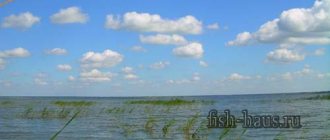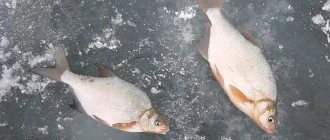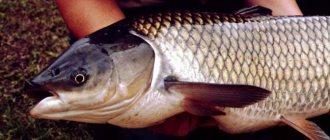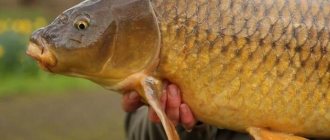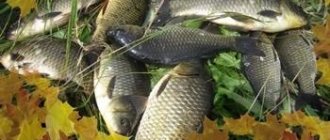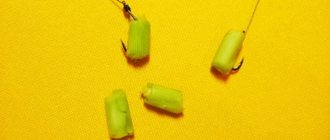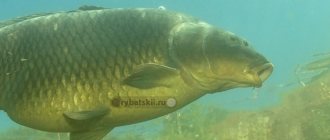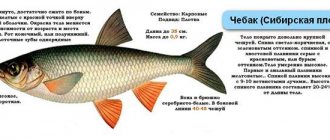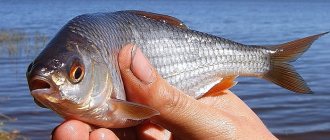An important feature of grass carp is that it actively eats various aquatic vegetation. This quality leads to the fact that the reservoir where it lives is gradually cleared of various algae. It is not found naturally in our latitudes.
In order to be able to catch it, grass carp are bred artificially. He eats quite a large amount of food. In practice, per day he eats an amount of food that is equal to his own weight.
Fishing calendar by fishing season
It is caught well from early May to mid-September. The weather he prefers is clear and calm. They catch it mainly during daylight hours. However, night fishing can also be successful.
If you prefer to catch this particular fish, then the likelihood that you will catch it in an ordinary body of water by accident is almost close to zero. You need to look for it where it is bred artificially. There is also a small chance of catching it in areas where it is not currently bred but has been in the past.
The most successful time will be early spring, a time when the grass has not yet begun to grow. Do not forget that this fish prefers warm water. The chances of catching will increase greatly when the water is warmer. The conditional limit can be considered a temperature of 15°C.
If the water is colder, there is practically no chance of catching grass carp. At temperatures below 10°C, this fish simply goes into a stupor and practically stops moving. At this time, trying to catch her is completely useless. What does such a fish do in winter? It gathers in flocks and, covered with a thick layer of mucus secreted by them, freezes immobile, waiting out the cold season.
Equipment
When using a feeder, the following installation methods are used:
- Gardner's paternoster.
- The tube is an anti-twist.
- Symmetrical or asymmetrical loop.
When fishing in still water, all the proposed methods of attaching the feeder have worked well. The fisherman should have several types of feeders, including “method” type feeders. From this feeder the food is washed out much faster than from traditional “cages”, which can attract grass carp to the fishing site much faster.
Tackle for catching grass carp
For this type of fishing, various fishing methods can be effective. Let's talk about some of them.
Match fishing rod
This tackle allows the fisherman to feel more confident. It provides a good opportunity to make a long and fairly accurate cast. If there is a baitrunner on the reel, then it can provide significant assistance in landing this large and strong fish.
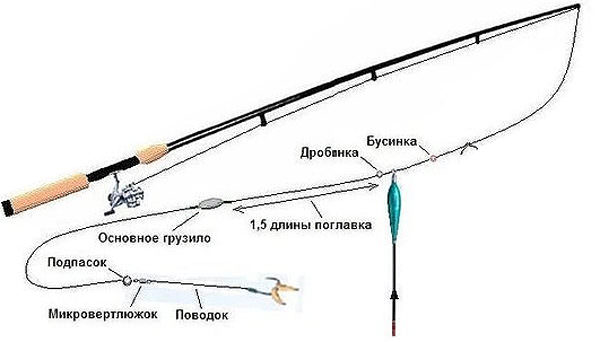
Structure of a match fishing rod
Grass carp can be found at different depths, so a running float is suitable for catching them effectively. With this fishing method, experienced fishermen do not recommend using braided line. The reason for this is its rigidity and good visibility in the water.
Plug fishing rod
This fishing rod is characterized by both its rigidity and long length.
It is not thrown, but simply held over a certain place. The bait is made using a special cup, which is delivered to the place using a fishing rod. A plug fishing rod allows you to make point bait in a strictly defined place and gives you the opportunity to play by lifting the hook up and releasing it. The only disadvantage of this gear is its high cost.
Bottom tackle
The use of such gear will be especially effective when fishing far from the shore. This is especially effective in the summer months, when the heat drives carp into deep layers of water.
Feeder
Feeder fishing is quite effective for catching grass carp. Installation of the feeder can be carried out in one of the following ways:
- Using a loop system.
- Using an anti-twist tube.
- Using Gardner's parternoster.
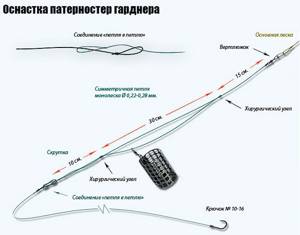
Gardner's Paternoster
Catching carp on flat, method on video
Sergey Popov plays a big role in popularizing the flat feeder, and in this article we suggest watching a video of how Sergey catches grass carps on the flat.
On the hair: fermented corn with the addition of floating (Pop-Up) corn.
To highlight the grains of the bait on the bait table, Sergey recommends using the honey aroma of Nutrabaits honey elite.
Fishing with fermented corn
As you can see, fermented corn is well suited for fish in this reservoir. At the end of the article we will provide a video from Sergei Popov on how to prepare it.
Key characteristics of the gear design
When catching grass carp, you need to take into account that it is not only an active and voracious fish, but also quite heavy. Therefore, the tackle to catch it must be powerful enough.
- Fishing line . Here you can use both braid and monofilament. At the same time, you need to understand that the cord will not only be rigid, but also too noticeable for the fish. The monofilament line, due to its elasticity, can somewhat weaken the jerks of this large and strong fish when playing it. It is recommended to take the thickness of the fishing line or cord no less than 0.6 millimeters.
- Leash . The leash should also be strong enough. Its minimum thickness will be 0.2 millimeters, but 0.4 mm or more is best.
- Hook . When biting, it is quite difficult to determine the moment when the carp needs to be hooked. Before swallowing the hook, he usually touches the bait with his lips several times, which looks like soft jerks. Therefore, it is very important that the hook is sharp enough and does not allow the fish to break off. The hook size should be 7 or 8.
- Rod . If you use too long a rod with little dough, then such a large fish can easily break away. It is best to use a not very long rod, 3.6 m long, with a test weight of at least 40 g.
- Reel _ The reel must also ensure the strength of the tackle and reliability during the fishing process. For this purpose, one with a size of 3000 is suitable.
Fishing rods and other equipment for bottom fishing for carp
The best answer to the question of how to catch grass carp on a donk is from professional carp fishermen. Tackle for catching carp and grass carp are similar in many ways. Therefore, it will not be a mistake if you use carp rods, reels and bite alarms. In addition, the method feeder and hair rig used for catching carp will be appropriate when fishing for carp.
The rod should be powerful and hold the fish well. It is desirable that the rings have a large diameter for better line movement between them. The reel is used with spools from 5000 to 8000. Grass carp can be caught well on a donkey if you use thick fishing line with a diameter of 0.35 mm. A fence is placed if the fishing distance exceeds 40 meters. But in general, you can get by with fishing line. Rodpods with signaling devices or ordinary stags are used as stands.
ribalka-vsem.ru
Grass carp bait
In order to attract prey, you don’t need to skimp on bait. However, it is necessary to take into account that not every bait will be used in this case. In its natural habitat, grass carp eats only plant foods.
You need to know that experienced fishermen, in addition to one-time pre-feeding, add a small amount of complementary feeding during the fishing itself. Also, do not forget about the excellent appetite of this fish. You will need quite a lot of bait. If there is too little natural food in the reservoir where it is bred, then this procedure significantly increases the chances of a good catch.
It’s just hard to find a place at random where it makes sense to catch it. To find his favorite places, you can use knowledge of some of his habits. At temperatures above 20°C it can be found in shallow water, where it comes to bask. If the temperature drops by about 5°C, then its favorite depth will be 4 m. These movements usually follow very quickly the change in weather. Sometimes just a few hours are enough for this.
In addition, you need to remember that it feeds on plant foods, which means you need to look for it where there is a lot of it.
For bait, you can use purchased mixtures that are intended specifically for this species or for carp. During their use, a cloud of white turbidity is formed, which can attract such fish. It is important to keep the cupid in one place for a long time. Therefore, the feeding procedure itself should be quite plentiful. It is important to note that you cannot overfeed this fish. She is too gluttonous for this.
Habitats and catches
Starting from a depth of 1 m and ending with depths of 4 m, you can hope for a successful bite of grass carp. Based on the fact that it is bred artificially, it can be found in irrigation canals, reservoirs near thermal power plants, as well as in ponds that require constant cleaning of aquatic vegetation. It can also be found in heavily overgrown lakes and ponds, where there is enough food for it. This fish feels safe near fallen trees, snags and other objects in the water.
Baits and lures
To attract it, you can use a variety of baits not only of plant origin.
- Animal origin . Even though it is a peaceful fish, some animal baits work well for it. In particular, we are talking about bloodworms, maggots or worms .
- Vegetable origin. Most plant baits will suit her.
It is important to choose ones that will stick well to the hook.These include various
filamentous algae, corn kernels or cucumber pieces .
Best bait
Initially, grass carp were caught on:
- cabbage leaf;
- green cucumber slices;
- dandelion leaves and stems;
- green pea or bean pods;
- various algae.
Such baits are still promising in our time, but the fish have become accustomed to new bodies of water and are not against trying baits such as:
- worm;
- bloodworm;
- crawling out;
- maggot.
At the same time, grass carp does not refuse peas, corn, wheat, etc. Given its varied preferences for different types of food, it is sometimes very difficult to choose an effective bait or bait. Therefore, when going fishing, it is better to take several types of baits with you and calculate the preference of grass carp, one by one sending them into the pond.
Some fishermen use tiger nuts to catch grass carp. This bait has a peculiar aroma that quickly spreads in the water and lures fish.
To prepare nuts, you need:
- Boil them in water for 1 hour.
- After finishing cooking. The nuts are infused in a bowl, wrapped in cloth.
- After cooling, an attractant is added to the mass to enhance the aroma.
- Ready-to-eat nuts are dried in the sun.
Baits of animal origin work well in stocked reservoirs, but traditional baits of plant origin are better used in reservoirs where there is little fish.
Tips and tricks
- Fishing should be done primarily where there is a lot of vegetation. It is in these places that there is a greater chance of meeting grass carp.
- You can't skimp on the bait. It takes a lot of it to attract this fish. Sometimes the total weight of dry bait reaches seven kilograms.
- For bait, you can also use a kind of “sandwich”, for example, maggots, bloodworms and algae .
- Cupid is excellent for catching at any time of the day. You can go fishing both during the day and at night.
- During the hot summer months, the fish avoids swimming near the surface and prefers to stay in the depths.
Finding a place to fish for white carp with a donkey
Grass carp are caught very well on a donk if you cast them not into holes, but into smaller areas. This factor determines the fishing distance. It usually does not exceed 35-40 meters. Moreover, the cupid takes the bait not from the bottom, but a little higher. If bream and carp constantly feed at the bottom, and their mouths vacuum the bottom, then cupid always looks straight and does not like to bend over.
The main condition for the presence of carp in a reservoir is the presence of algae and coastal vegetation. If there are a lot of these components, then cupid will be caught well.
Tactics for catching carp
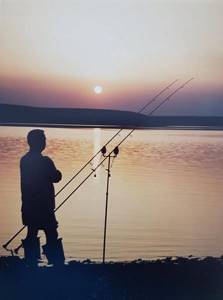
I almost always START and END my fishing sessions with SINGLE baits. And there are good reasons for this! Firstly, when I finish setting up my camp and reconnaissance of the surrounding area (which, by the way, is very important!), it is quite likely that there is already cupid within the fishing range, which will definitely leave after my “bombing” with bait. It’s worth noting here that I managed to catch quite a decent number of epic specimens – precisely while setting up the camp! And, secondly, at the very end of my session - I don’t want to leave too much bait, thereby increasing the chances of eating the bait on the hook, and not the bait particles. Thus, somewhere in the middle of my fishing, I begin to greatly reduce the amount of bait, actually stopping feeding completely - closer to its end.
What to catch?
As I already said, grass carp is a herbivorous fish , so it needs to be caught using various plant baits. This is frankly not a common thing, especially if you have never caught this fish.
Let's start with young cucumbers that may be of interest. However, for this you will need young, fresh cucumbers; it is best not to use old, yellow ones, as they are bitter. Catching a cucumber is quite simple, cut it into cubes and send it to the pond. It is best not to hide the sting of the hook; this usually does not bother the fish.

Naturally, this is not all the bait that can be used. Cupid also bites well on reeds. To fish with reeds, it is enough to cut off a young shoot of the plant. Now you need to disguise the hook, which we wrap with reeds.
Cabbage leaves are also used when fishing for carp. To do this, it is worth using the leaves that are closer to the head of cabbage. We cut the leaves into strips so that the vein of the leaf remains intact.

White bread is also used for fishing. To do this, you need to take a piece of stale bread (as it floats better). We thread a hook through a piece of bread, hide the sting completely in the crust and send it into a pond. If there is a lot of fines in the pond, then take a larger piece. It is worth fishing with such bait if you see splashes of carp on the surface.

Of course, this does not mean that carp can only be caught using plant bait; it can also be caught using boilies, corn, peas, worms, etc. But, if there is enough vegetation in the reservoir, this is difficult to do.
Many anglers argue that catching grass carp from the bottom is not the best option. But, there are times when the fish takes it from the bottom. Therefore, you need to experiment.
You also shouldn’t forget about bait, as it increases your chances of catching fish.
